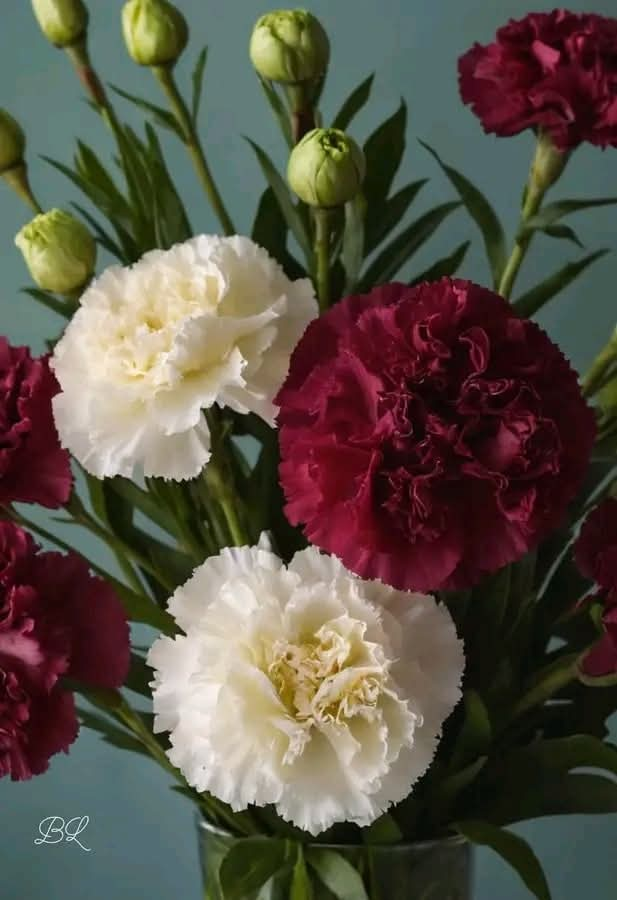Carnations, with their delicate, ruffled petals and captivating scent, are one of the most beloved flowers worldwide. This particular variety, showcasing deep maroon and creamy white hues, exudes elegance and sophistication. Whether enhancing a garden or gracing a bouquet, these versatile blooms make a stunning impression.
Why Carnations Are a Classic Choice
Vibrant Appearance: The multicolored, intricately ruffled petals offer unmatched beauty.
Fragrance: Their subtle, spicy scent adds charm to any setting.
Longevity: Carnations are known for their long-lasting blooms, making them ideal for cut flowers and arrangements.
Carnation Care Guide
Light Requirements
Preference: Full sun to partial shade.
Tip: Provide at least 4-6 hours of sunlight daily for optimal growth and blooming. In hotter climates, partial shade during the afternoon is beneficial.
Watering Needs
Frequency: Keep the soil consistently moist but not waterlogged.
Method: Water at the base of the plant to prevent fungal issues. Avoid overhead watering.
Soil Conditions
Type: Rich, fertile, well-draining soil is essential.
Amendments: Add compost or organic matter to improve soil fertility and drainage.
Temperature Preferences
Optimal Range: 60-75°F (16-24°C).
Frost: Carnations are not frost-tolerant. In colder climates, grow them as annuals or bring potted plants indoors during the winter.
Humidity
Level: Moderate to high humidity is ideal. In dry conditions, consider misting the plants occasionally to maintain moisture levels.
Fertilization
Frequency: Use a balanced, slow-release fertilizer every 2-3 weeks during the growing season (spring through early fall).
Tip: Avoid over-fertilizing, as this can lead to excessive foliage growth at the expense of flowers.
Tips for Growing Healthy Carnations
Deadheading: Remove spent blooms regularly to encourage continuous flowering and maintain a tidy appearance.
Staking: Tall varieties may require staking to support their stems and prevent breakage.
Spacing: Plant carnations at least 8-12 inches apart to ensure proper air circulation and reduce the risk of disease.
Mulching: Apply a layer of organic mulch around the base to retain soil moisture and regulate temperature.
Pest Control: Watch for aphids, spider mites, and thrips. Treat infestations with insecticidal soap or neem oil.
Uses for Carnations
Garden Displays: Plant them in borders, rock gardens, or as edging plants to create a vibrant, colorful display.
Cut Flowers: Their long stems and lasting blooms make carnations perfect for floral arrangements and bouquets.
Container Gardening: Grow carnations in pots or hanging baskets to brighten up patios, balconies, or indoor spaces.
Symbolism: Often associated with love, admiration, and gratitude, carnations are a thoughtful choice for gifting.
Frequently Asked Questions
Q: How long do carnations bloom?
Carnations typically bloom for several weeks during the growing season. Deadheading and proper care can extend their blooming period.
Q: Can carnations be propagated?
Yes, carnations can be propagated through cuttings or by dividing mature plants. Take 4-6 inch cuttings in early spring, dip them in rooting hormone, and plant them in a well-draining potting mix.
Q: Are carnations suitable for indoor growing?
Absolutely! With adequate sunlight and care, carnations can thrive indoors. Place them near a sunny window and ensure the pot has proper drainage.
Why Choose Carnations for Your Garden?
With their timeless beauty, delightful fragrance, and low-maintenance nature, carnations are a favorite among gardeners and flower enthusiasts. Whether adorning your garden or enhancing your home decor, these stunning blooms are sure to impress.
Bring the charm of carnations to your space and enjoy their vibrant colors and captivating elegance all season long! 🌺✨
